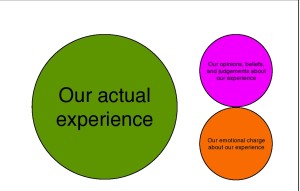There are three yogis in a cave. They’ve been there, practicing meditation for the last 10 years. Around the tenth year, something moves by the mouth of the cave. One yogi murmurs, “I think that was a rabbit." A year later, another yogi whispers, “No, I think that was a squirrel.”
Six months later, the third one blurts, “If the two of you don’t stop fighting, I’m going to have to leave this cave."
There’s a misperception that to be mindful means to be a detached navel-gazer in a cave, that being present and aware is devoid of creativity and passion. Mindfulness, in fact, highlights our passions.
By bringing us fully into the experience of the here-and-now, we are more aware, allowing us to appreciate each moment with far greater subtlety: a bursting feeling in the heart when we realize we are in love; the uplifting quality of a new and creative idea; the power when we sense our connection to a cause that aligns with our deepest values.
Because our senses are more enhanced, we can grasp more clearly what is actually calling us among the myriad, transitory complications of our modern lives. We can also see who we are with less judgment and more acceptance. Sometimes even more importantly, we see the inauthentic roles we have been playing out, those roles that do not reflect who we are essentially.
When we stop wanting to be someone else, we can finally recognize our unique gifts, talents and passions and what we want to do with our “one wild and precious life.” We can let go of playing by everyone else’s rules—our parents, our bosses, our partner’s, society— and start to ask the question, “What matters to me?”
Make Your Life Your Message
When asked for his message for the world, Gandhi responded with the now famous line, “My life is my message.” Is your life a reflection of your message? To live such a life, is to live passionately, as Gandhi did.
Webster dictionary defines passion as, “a strong liking or desire for or devotion to some activity, object, or concept.” At its core, passion is an interior force, a sort of current that drives and energizes us to understand and merge with the object of our passion. It can be an activity, a quality of mind, a path and, of course, it can be another person or animal. When we are not living in accordance or in harmony with our passions, our lives feel discordant, lifeless, flat and hollow.
In contrast, when we live with passion, we are compelled and fueled with enthusiastic emotion. Whatever the object of our passion, it connects us to a greater sense of purpose, the feeling that we are part of some greater whole. It also leads us to a greater understanding of what makes us unique; whatever the object of our passion, it is our very own.
It is not something to be found somewhere other than where we are. It is already inside of us, yet for most of us, passion is ill-defined. Instead, it is a lived experience that emerges in subtle inklings. It can show up at the birth of a child, a sunset, the completion of an arduous journey or the beginning of a new one. Our passions often can be discovered in the activities where we completely lose ourselves, be it a sport, a hobby or a particular kind of problem solving.
We are not always aware of our passions because we are so busy with our to-do lists. It also does not help that many of us were told that our passions were not practical, that if we followed them, we likely would not succeed or we would not make enough money to get by. We learned to turn a blind eye to the glimmer of a calling. Regardless of the cause, for most of us, our passions are hidden.
Obsession and Clinging
Our passions can also blind us. When our passions control us, they can lead toward obsessions. When overdone, passion can completely undo our lives. Just think of the seven deadly sins: pride, envy, wrath, lust, gluttony, lechery and sloth. In Buddhism, each sin is considered a form of grasping or clinging. When we obsessively clinging to the pleasant feelings that passion can fuel, we forget that like all things, even passion is impermanent: it comes; stays for awhile; and eventually passes away.
We are all vulnerable to obsessive passion. We all get lost in it sometimes. Wealth, power and fame can be alluring for each of us at times. Mindfulness practices are not moralistic. Because we meditate does not mean that we should not abstain from enjoying the things we have or pursue success.
Instead, our practices have the potential to show us our embodied response of when passion has overtaken us and when we have become attached. We can be sure that we are working with clinging when we find ourselves on the hunt for increasingly greater thresholds of success and, at the same time, are despondent at its loss or evading quality.
Mindfulness practice helps us maintain an even quality of mind. It helps us to see that whatever success we have attained in following our passion, it does not define us, nor is our happiness dependent on it. The practice itself helps us remain discerning. We use the practice to distinguish wisdom from delusion, to make choices that are life enhancing not only to ourselves but others, as well.
So enjoy what lights you up. Explore all the varieties of California Pinots. Protest race inequality. Make music that delights you. Sweat your prayers. Make love with abandon. And bring your mindfulness practice to each experience: breathing with it, sensing it and ride the wave all the way until the end. And when it is over, let it go.

